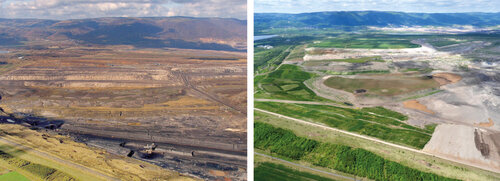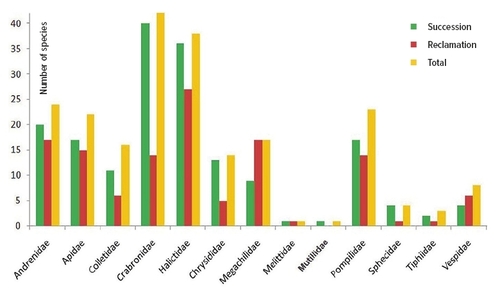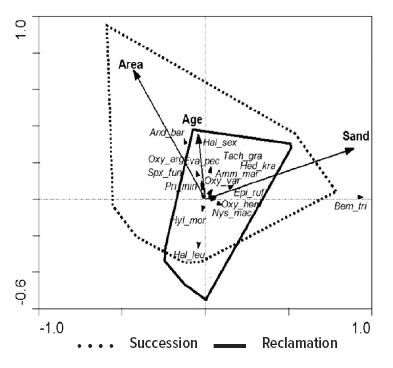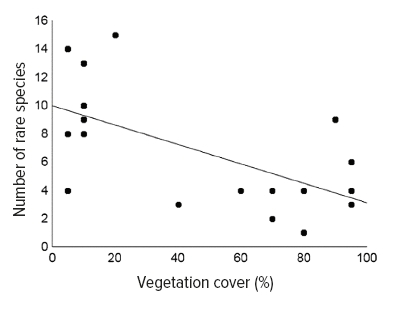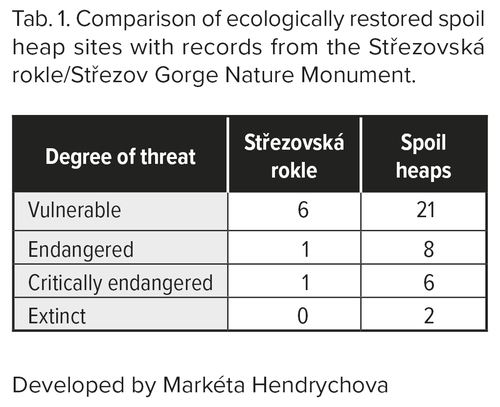Nature Conservation 2022 — 25. 5. 2022 — On Nature in the Czech Republic — Print article in pdf
What Attract Rare Invertebrates to Brown Coal Spoil Heaps?
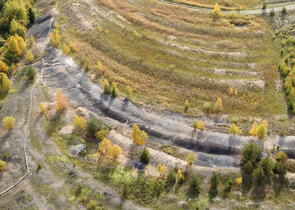
The lunar landscape image of coalmine regions keeps clinging to people’s minds, despite the fact that a lot of good has happened since the boom of brown coal surface mining below the Krušné hory/Ore Mountains (northwestern Bohemia). Mining companies are in good faith fulfilling their mining obligations including the reclamation of spoil heaps and residue pits in extensive surface quarries as is imposed by law, primarily the Mining Act, the Forest Act and the Act on the Protection of Agricultural Land. An area of more than 12,000 hectares has already been technologically and biologically reclaimed, and at least CZK 20 billion (EUR 0.8 billion) have been invested there (figure converted to today’s value of the Czech Crown based on common reclamation prices) from the miners’ financial reserves as well as governmental resources (see www.15miliard.cz).
Reclaimed areas have been green, pastures are full of cows, older reclaimed woodland is hardly different from that around spoil heaps. Residents enjoy leisure time in parks, swim happily in crystal clear lakes or visit sports grounds frequently… As we have known, however, less is more. This is definitely true for rare wild animal species.
Figure 1 Great changes in the post-mining landscape of the Vršany quarry – left: 2011,
right: the same area after 10 years. © Markéta Hendrychová
A landscape you cannot create yourselves
Brown coal spoil heaps result on the one hand in varied terrain in all aspects, on the other hand they cause special climatic and other site condi- tions, particularly oligotrophy, which makes areas remaining after mining very interesting from the perspective of nature conservation (but also aesthetics, possible adventures and other ecosystem services), and that without any further human intervention. Something similar and extensive cannot be created in a common landscape. The national uniqueness of post-mining sites has been observed for many years (e.g. Bejček 1981 and Prach 1989 as the first ones). Although we wrote “remaining” (without technological recla- mation), nature does certainly not just sleep. Just on the contrary. New life rapidly arrives at fresh spoil heaps, various species fight for space, new and changing communities interact with at the same time developing soil (Frouz et al. 2008), large numbers of amphibians settle spontane- ously and dynamically changing pools in small depressions (Vojar et al. 2016), rare birds nest abundantly in various places, from mining ma- chines to old, mostly closed-canopy woodland, which have developed there spontaneously without having to plant a single tree (Šálek 2012). Many remarkable ecological processes hardly recorded in the landscape elsewhere can be observed and studied there. Nevertheless, these are rather small habitats and difficult to perceive. It is very hard or impossible to maintain such valuable sites/areas in the post-mining landscape permanently, since formerly approved general remediation and reclamation plans are strictly adhered to, and most of all there is pres- sure on a return them to farmland and forests. Therefore, technological and subsequently bio- technical reclamation strongly prevail: landscape elements are homogenised, the soil is enriched with minerals, and biotopes unique to the Czech Republic’s landscape therewith gradually disappear. In the article, we would like to demonstrate the value of non-reclaimed parts on the example of invertebrates, which are regarded good bioindicators thanks to their species richness and diversity in ecological requirements (Majer 1998). Our studies have mainly dealt with taxa inhabiting predominantly aboveground parts of ecosystems, which may well reflect the soil environment (where often their juvenile stages take place), as well as with vegetation which provides them with shelter and food.
Invertebrates in forests
Since succession in the northern Bohemian landscape should most often direct to forest communities, our research started with com- paring communities of the selected invertebrate taxa in forest reclamations and woodland spon- taneously formed on spoil heaps (without planting and subsequent management, hereinafter ‘succession’). We only studied plots with a cover of trees (min. 5 m tall) of more than 50%. We further made sure that the distance of the study plots to the margin of the vegetation was min. 50 m and captured stands of different ages, from 18 to 45 years. A total of 14 one-hectare large succession plots and 14 reclaimed plots were selected, situated at least 500 m from each other. In each study plot, three sites representing a gradient in shading (i.e. in tree and shrub layer density) were chosen. In the 20-metre surrounding also the following parameters were assessed: humidity (categories dry, partly wet, and wet), cover (%) of vegetation layers, dominance of particular tree species, average height of herb cover, plant species richness, terrain slope (degree), microclimate (mild or severe with regard to prevailing southern or northern winds), proportion of deadwood (low, medium, high), litter depth, and microtopography (flat, terrain unevenness <20 cm, or >20 cm).
As model groups, seven taxa (see Fig. 2) were used. Their representatives were captured from May to September by sweeping vegetation, pitfall traps with bait, whereas molluscs were also collected manually for 15 minutes at each site. At the same time, soil samples were taken, from which total nitrogen content (NC), Ca, P, K, and Mg, grain composition, sorption (S – sum of basic cations) and sorption capacity (T) were determined. To reduce pedological and habitat variables, Principal Component Analysis (PCA) was performed, resulting in correlated variables (see PC1 a PC2 in Tab. 1) explaining 48% of variability. Subsequently, the effect of soil variables and site management on the species richness at the sites was assessed by a linear mixed-effects model.
Figure 2 Diversity index and species numbers in the monitored taxa at reclaimed and spontaneously developing spoil heaps in the North Bohemian Brown Coal Basin. © Markéta Hendrychová
Succession or reclamation? Combine them!
Detailed results of the research have been published by Hendrychová et al. (2008, 2016), therefore only the most important conclusions are mentioned here. A total of 16,003 individuals of 140 species were identified. Nearly half of the species (47%) were found to inhabit reclaimed as well as succession plots, but as many as 37% of species were only documented from succession plots, which is much more than the 16% which occurred exclusively in reclaimed plots. The diversity of ground beetles (Carabidae), heteropterans (Heteroptera) and isopods (Isopoda) was statistically significantly higher at succession plots, while the other taxa did not differ much in species numbers. The species diversity index was higher at succession plots both in the case of the pitfall trap method and sweeping (Fig. 2).
The species richness of all monitored taxa, except for molluscs (Mollusca) and centipedes (Chilipoda), was shown to be influenced by microclimatic site conditions. Species composition was further influenced by pedological characteristics in various ways: a higher humus content, thicker litter layer and presence of deadwood in combination with terrain/land cover heterogeneity and site management mostly acted in a positive way.
An essential driver influencing invertebrate communities is soil handling (e.g. changes in the proportion of clay particles and granular components and in mineral content, relief shaping – also see Moradi et al. 2018 and Vicentini et al. 2020). In this way the diversity as a whole but also particular species can be supported. For example, the presently rare ground beetle, the Bombardier beetle (Brachinus crepitans) inhabits acidic forest soils in spontaneously developing woodland in large numbers. Also the vertical as well as horizontal vegetation structure plays a significant role there. Both ornithological and entomological research has confirmed the positive effect of small open patches (Šálek et al. 2010). For example, Šebek et al. (2016) describe the irreplaceable importance of sunlit trees in half-open woodland for arachnids (Arachnida), beetles (Coleoptera) and hymenopterans.
Rare bees and wasps enjoy sandpits
The group of stinging insects (Hymenoptera: Aculeata) on spoil heaps was the next, non-forest experiment we dealt with (Hendrychová & Bogusch 2016). This included 114 collection plots at 3- to 35 year old sites (without significant age differences between succession and reclaimed study plots). Using coloured Moericke traps, a total of 2,706 individuals, 212 species of 13 families, were captured (Fig. 3). As many as 54 species (2 extinct from the region, 7 critically endangered, 14 endangered and 23 vulnerable) were classified as rare, 5 species as legally protected, and also 3 other rare (rapidly declining) species were recorded. The assumption of higher species richness at non-reclaimed sites was confirmed: succession plots were found to inhabit twice as many rare species in four times higher numbers (84 species only captured at succession plots). This occurrence was not exceptional, as red-list species settled at 35 succession plots and at only two reclamation sites. Two species regarded extinct from the Czech Republic, namely the spider-hunting wasp Evagetes littoralis and the cleptoparasitic bee Nomada minuscula, were only recorded in succession plots, the inner spoil heap of the Vršany quarry and the Radovesice spoil heap (today registered Significant Landscape Elements). Species of sands and open landscapes (64%) prevailed and mostly belonged to the group of ground-nesting species (59 %). Pollen and nectar collectors exceeded predators and parasitic species in number. Rare species and high biodiversity are correlated to sandier (granular) substrates (Fig. 4). Interesting habitats have also been developing in places with residual coal affected by strong erosion, or with sparse vegetation for other reasons (Figs. 5 and 6). These are not nec- essarily large areas – a number of small sandpits is enough (Fig. 7).
Figure 3 Representation of different families in the studied reclaimed, succession and all post-mining plots. © Markéta Hendrychová
Figure 4 Redundancy Analysis, RDA (explaining 76.2% of variability), confirms, inter alia, that the sandy or early succession environment hosts a larger number of rare species. A wider range of these characteristics is offered by non-reclaimed sites. © Markéta Hendrychová
Figure 5 Spoil heaps were dominated by Aculeata preferring open and sandy habitats. © Markéta Hendrychová
Figure 6 The number of rare Aculeata species decreases with increasing vegetation cover. © Markéta Hendrychová
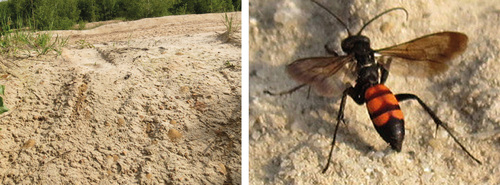
Figure 7 Nest colony of the critically endangered digger sand wasp Bembix tarsata on sandy slope of an erosionaffected part of the Radovesice spoil heap with very sparse vegetation (left) and the psammophilous Black-banded spider wasp (Anoplius viaticus) (right), commonly inhabiting non-reclaimed spoil heaps.
© Markéta Hendrychová
We supplemented these studies with research into the Střezovská rokle/Střezov Gorge Nature Monument nearby the Doly Nástup Tušimice quarry, where Aculeata are the main subject of conservation. Spoil heaps were found to be many times more significant in occurrence as well as abundance of rare species (Tab. 1).
Tab. 1. Comparison of ecologically restored spoil heap sites with records from the Střezovská rokle/Střezov Gorge Nature Monument.
What to apply in practice
If nature conservation must be the only target of restoring a post-mining landscape, the most appropriate approach turns out to be a well-considered combination of technological and biological reclamation using natural restoration processes or possibly management which blocks succession and reduces dense vegetation cover, a state which all reclaimed sites direct to. The results of our entomological research show that presence of a fine mosaic of different habitats including shrubbery and species-rich grasslands (even as a part of reclamation) is important for a high species diversity and occurrence of rare and endangered species. If we allow not only for succession sites but also small non-production habitats like hedgerows, baulks and fallows, insects will pay us back in adjacent arable fields where they pollinate, regulate crop pests, etc. As indicated by the preliminary results of our study into orthopteran insects on brown coal spoil heaps, besides diversity in soil characteristics and presence of terrain unevenness, the species diversity of restored grasslands is also essential.
Acknowledgements
We thank the following entomologists for their fantastic assistance with collecting and identification of invertebrates: J. Růžička, K. Tajovský,
- Kment, O. Nakládal, J. Kupka, K. Hradil,
- Sirovičová, A. Červenková, M. Oktábec,
- Radics, Z. Jarkovská and V. Drozenová. Part of the research was supported by grant GACR 105/09/1675, Specific Research of the University of Hradec Králové No. 2101/2015, and by grant No. 42900/1322/3208 of the Faculty of Environmental Sciences of the Czech University of Life Sciences Prague.
■
- - -
Intro photo: A diverse mosaic of habitat patches suitable for specially protected species including sites with sparse vegetation or bare substrate where rare stinging insects breed. The Velká podkrušnohorská výsypka or Great Krušné hory/Ore Mountains Foothills Spoil Heap, the Sokolov area. © Markéta Hendrychová
- - -
List of referencies
Bejček, V. (1981). Vliv lesnické rekultivace výsypek po povrchové hnědouhelné těžbě na společenstva drobných savců. Sborník Okresního muzea v Mostě, řada přírodovědná, 3, 117-131.
Frouz, J., Prach, K., Pižl, V., Háněl, L., Starý, J., Tajovský, K., Materna J., Balík V., Kalcík J. & Řehounková, K. (2008). Interactions between soil development, vegetation and soil fauna during spontaneous succession in post mining sites. European journal of soil biology, 44(1), 109-121.
Hendrychová, M., Šálek, M., & Červenková, A. (2008). Invertebrate communities in man-made and spontaneously developed forests on spoil heaps after coal mining. Journal of Landscape Studies, 1, 169-187.
Hendrychová, M., Šálek, M., Tajovský, K., & Řehoř, M. (2012). Soil properties and species richness of invertebrates on afforested sites after brown coal mining. Restoration Ecology, 20(5), 561-567.
Hendrychová, M., & Bogusch, P. (2016). Combination of reclaimed and unreclaimed sites is the best practice for protection of aculeate Hymenoptera species on brown coal spoil heaps. Journal of insect conservation, 20(5), 807-820.
Majer, J. D. (1989). Animals in primary succession-The role of fauna in reclaimed lands. Cambridge University Press.
Moradi, J., Potocký, P., Kočárek, P., Bartuška, M., Tajovský, K., Tichánek, F., ... & Tropek, R. (2018). Influence of surface flattening on biodiversity of terrestrial arthropods during early stages of brown coal spoil heap restoration. Journal of environmental management, 220, 1-7.
Prach, K. (1989). Sukcese vegetace na Mosteckých výsypkách–účast jednotlivých druhů. Severočes. Přír., Litoměřice, 23, 77-83.
Sebek, P., Vodka, S., Bogusch, P., Pech, P., Tropek, R., Weiss, M., ... & Cizek, L. (2016). Open-grown trees as key habitats for arthropods in temperate woodlands: The diversity, composition, and conservation value of associated communities. Forest Ecology and Management, 380, 172-181.
Šálek, M., Hendrychová, M., & Řehoř, M. (2010). Breeding habitat of sparrowhawks, Accipiter nisus on spoil heaps after coal mining. Acta Oecologica, 36(2), 197-201.
Šálek, M. (2012). Spontaneous succession on opencast mining sites: implications for bird biodiversity. Journal of Applied Ecology, 49(6), 1417-1425.
Vicentini, F., Hendrychova, M., Tajovský, K., Pižl, V., & Frouz, J. (2020). The Effect of Topography on Long-Term Spontaneous Development of Soil and Woody Cover on Graded and Untreated Overburden. Forests, 11(5), 602.
Vojar, J., Doležalová, J., Solský, M., Smolová, D., Kopecký, O., Kadlec, T., & Knapp, M. (2016). Spontaneous succession on spoil banks supports amphibian diversity and abundance. Ecological Engineering, 90, 278-284.


